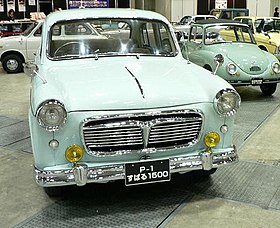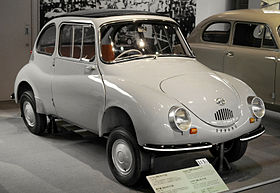 Subaru 1000
Subaru 1000
The
Subaru 1000 was the first
front wheel drive Subaru produced by
Fuji Heavy Industries that was in the
Japanese government "compact car" classification starting in 1966. Previous Subaru models such as the
Subaru 360 and the
Sambar had been rear-engined, rear wheel drive
kei cars.
It was the first production Subaru to use a
boxer engine.
In 1960, Subaru management decided to introduce a successor to the prototype
Subaru 1500
with a new code name "A-5" with a four-cycle air-cooled horizontally
opposed four-cylinder engine displacing 1500 cc, driving the front
wheels in a compact car platform. It was to have a
double wishbone
front suspension. Due to FHI's limited resources, the car wasn't
produced. The Subaru 360 was selling at the time but Subaru wanted a car
that could comfortably carry four passengers without a cramped
compartment, that would appear to be an alternative to the
Toyota Publica, the
Datsun 110/210, the
Hino Contessa, and the
Mitsubishi Colt 600.
Subaru also wanted to reduce engine noise by placing the engine up
front and improve interior space by implementing front wheel drive,
thereby eliminating a centrally mounted
drive shaft
powering the rear wheels, and utilizing an independent suspension at
all four wheels. The only other Japanese company to use an air-cooled,
horizontally opposed engine at the time was in the Publica, and the
Toyota U engine.
In 1963, Subaru tried again, with a new project code "A-4", with a
smaller 923 cc engine, front wheel drive, and an overall length of
3,885 mm (153.0 in), a wheelbase of 2,400 mm (94 in), a front wheel
width of 1,230 mm (48 in) and a rear wheel width of 1,220 mm (48 in),
weighing 500 kg (1,100 lb). It made it towards production status and was
changed to production code "A-63" and was eventually introduced as the
Subaru 1000. To address space efficiency and a quiet operation with
minimal vibration, the engine was developed as a
water-cooled engine instead of the original intent of air-cooled in the "A-5" concept.
The Subaru 1000 was formally introduced on October 21, 1965 at the
Hilton
Hotel Tokyo, now known as the Hotel Tokyu Capitol. It was shown at the
12th Tokyo Motor Show Sunday October 29 later that year. It was
available for purchase May 14, 1966 with a national release in Japan in
October 1966. Its model code was A522. The two-door sedan, model A512
was introduced February 15, 1967, with a four-door van released
September 14, 1967.
These cars featured a unique water-cooled, horizontally opposed four-cylinder engine, with overhead valves operated by
pushrods. Subaru engineers examined
Porsche,
Volkswagen and even
Chevrolet Corvair
and thought it would be nice if this type of engine is combined with
front wheel drive system. The neck in proceeding the mechanism was the
vibrations from
universal joints, but in collaboration with the bearing maker Toyo Bearing (now known as NTN), the epoch-making "
double offset joint"
was invented. Modern Subarus still make use of horizontally opposed
four-cylinder engines, albeit of a much greater capacity and with more
modern overhead-cam-driven valves.
As was typical of early front wheel drive cars, the 1000 featured
inboard drum brakes up front to reduce unsprung suspension weight and an
easier implementation of an independent front suspension (but
atypically Subaru would retain this unusual design into the seventies).
Other unique features of the 1000 were a lack of a
heater core, the heating system took its warmth directly from the radiator, and a hybrid suspension system that used
torsion bars in combination with coil springs (much like the front suspension of the
Subaru 360). The 1000 was superseded by the 1100 (also known as the
Subaru FF-1 Star in the United States and in other export markets) at the start of the seventies.
By March 1969, Subaru had produced over 4,000 units as an alternative to the
Toyota Corolla series KE10 (introduced in 1966), and the
Nissan Sunny series B10.












